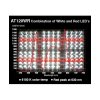brotherjericho
Well-Known Member
Been in analysis paralysis mode on choosing possible spectrums for a potential customized panel from either Cidly or Bysen (finally got a response, they do custom!). I've read some suggestions that the 630nm:660nm ratio in a grow light should be roughly 2:3, but that's with some other colors thrown in the mix. Right now, neglecting the other colors for the sake of discussion, why would we want more 660nm than 630nm? Seems it should be the other way around. Can anyone shed light on this subject?
In addition, I see a trend with no actual 630nm, just a mix of CW or WW with 660nm, with the whites contributing to the 630nm.
Thanks!
EDIT: Consideration is for a flowering panel only, I have seen the study on tomatoes where it seems the best 400-500nm:500-600nm:600-700nm ratio is 10:15:75 but that doesn't really specify the differences on using 660nm and 630nm.
In addition, I see a trend with no actual 630nm, just a mix of CW or WW with 660nm, with the whites contributing to the 630nm.
Thanks!
EDIT: Consideration is for a flowering panel only, I have seen the study on tomatoes where it seems the best 400-500nm:500-600nm:600-700nm ratio is 10:15:75 but that doesn't really specify the differences on using 660nm and 630nm.




